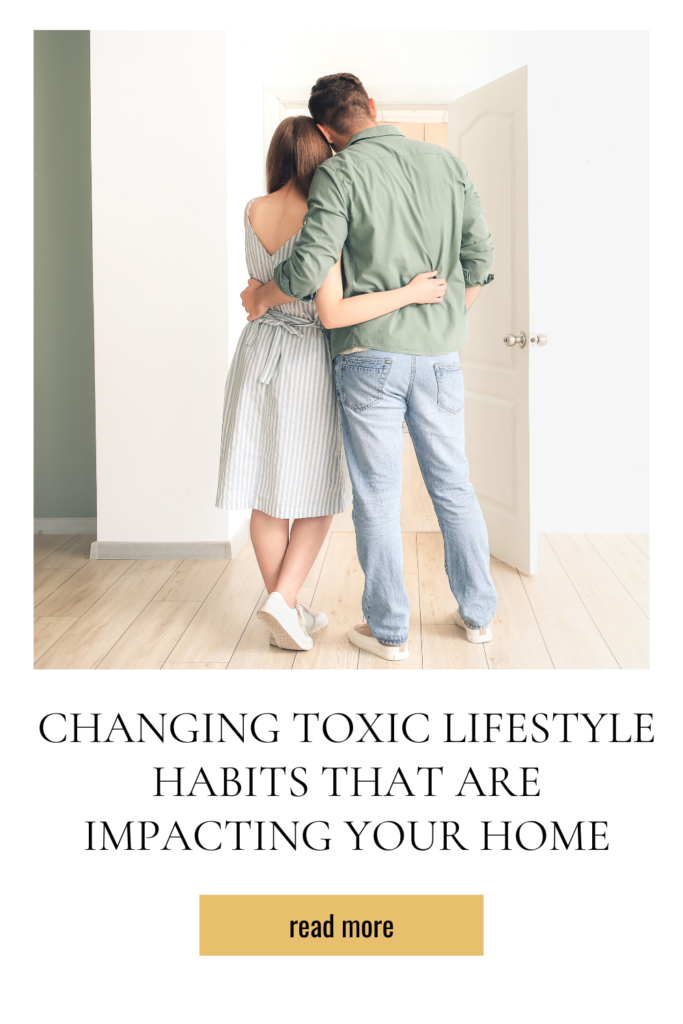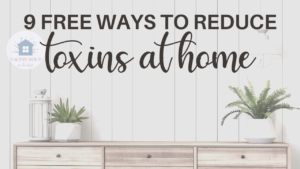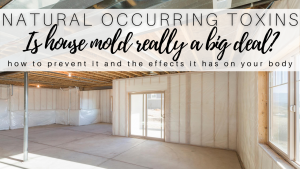
In so many ways, I’m probably just like you. I didn’t always want or see the need to have a natural home. In fact, quite the opposite, I wasn’t aware nor did I really even care about toxins. I kind of had a mentality that I was invincible, and it was a waste of time to worry about things that could be affecting my health. I’ve been fine so far, right?
I had really always been fairly health conscious, but the extent of my health and wellness knowledge was wrapped up in exercise and eating habits. I had focused solely on calories instead of true nutrition and I had focused on strenuous workouts that were hard on my body instead of using exercise to benefit my life in areas like stress reduction and my mental health.
I had never focused on toxins, truly holistic approaches to health and wellness or a more natural style of living. Until I had kids, that is. Once my children arrived my priorities shifted and being the healthiest I could be for them became a huge focus. Around the same time I started seeing growing concern for toxins. Initially, I wrote it off, however as I read more and opened myself up to more natural approaches for my overall health and wellness.
And I’m sure if your journey has been anything like mine, all roads lead to a whole lifestyle change, including a more natural home.
But maybe you’re also like me in the sense that not every natural home change is possible, or feasible. But what do you do with these areas of your home and lifestyle that then contain toxins? How can you move forward with peace of mind?
This is the single spot that stops so many families in their tracks. When it feels like there’s a roadblock due to money or time, oftentimes they don’t move forward and progress halts altogether. Some families even fall back into old habits and products.
But the good news is that there are SO many things you can do with these areas that feel “too big” or that require more time and resources than we have. I’m about to show you how to keep going when you feel a little stuck and make some really significant changes in your home.
CREATING A NATURAL HOME: SOME CHANGES ARE NOT FOR EVERYONE
To be honest with you, some changes that families make to incorporate healthy habits into their natural home are not for everyone. Each and every suggestion you read or hear should be evaluated to see if it’s a good fit for your family.
I based my natural home changes on a few different basic areas of my life and home:
Money: Some changes you may want to make to your home, whether it be a natural home improvement or not are expensive. And sometimes, the payoff may not be worth it in the end. Sometimes a really expensive change (such as changing out flooring, replacing drywall, etc), may be an expensive replacement and it may not be improving your natural home all that much. For example, if you were concerned about the toxins present in your furniture that contained particle boards, you could replace your furniture with solid wood. This is a REALLY expensive change, but would eliminate some VOCs from your air and your home.
In the same breath, a less expensive change for your natural home could be getting rid of all your plastic kitchen containers and replacing them with glass. This costs a lot less, but is still removing a toxin from your everyday life.
When it comes to any natural home change, I assess the amount of money I’ll be spending to improve my space. It doesn’t mean I won’t make this change in the future if it’s an expensive change, but it does mean I may budget for it in the future rather than make the change right away.
Stress: Some changes can add a lot of stress to your life. If your natural home improvement is updating your home from toxic carpeting to natural hardwood, this can add some stress to your home and life while you’re making this change. The natural home improvements that are larger in scale and more labor intensive projects don’t get skipped over, but there’s definitely a time for them.
As a family we plan and prepare for these changes and projects to make sure we are minimizing the amount of construction and dust being drummed up inside the house. A natural home doesn’t have to be perfect right away. Oftentimes it’s a long journey and process to get it to where you want. Sometimes it may mean breaking a large project down into several small projects. For example in our house, the kitchen is an area that will eventually be redone. But at the current moment, we’re just tackling the flooring. This puts less stress on our home and lifestyle. Eventually we’ll upgrade our cabinets to a healthier option, but it just isn’t something that we’ll be taking on right now.
Lifestyle: The changes you make to your natural home MUST align with your lifestyle. Families that have a more relaxed lifestyle at home are going to prioritize health and wellness changes differently than those with on-the-go lifestyles. Both are completely easy to work with, they will just look different in each household.
Assess any changes you want to make and ask yourself if they will really be worth it for your current lifestyle. I should also note that lifestyles change as your kids grow and change as well. For example, a home with babies will make different changes to their natural home environment in comparison to a family that has older kids or no kids at all.
Look at the things you’re willing to sacrifice in the name of having a natural home and be okay with deciding a particular change is just not for your family.
Impact: Another area that I really try to focus on is just HOW much of a positive impact my debated change will really impact our health and wellness. A natural home that’s completely toxin free may exist, but they are few and far between. The truth is we WILL be exposed to toxins, and often they are within the four walls of our home. The goal is not to mitigate EVERY toxin, but to minimize them as much as possible.
Some home improvements will have a greater impact on the health and wellness of your natural home environment than others. For example, replacing all your vinyl windows (which contain phthalates, VOCs, polyvinyl chloride and other toxins) will likely reduce SOME toxin exposure within your home.
In the same breath, for a fraction of the price, you could install an air exchanger to improve the indoor air quality within your home. This type of improvement brings in natural, fresh air from outside and pushes the toxic air outside, drastically improving your environment Both of these improvements will improve the indoor air quality within your natural home, but installing an air exchanger probably has a greater impact on the health of your home (especially when you’re also calculating impact based on cost).

WHAT TO DO WITH TOXIC AREAS OF YOUR NATURAL HOME
With each improvement we consider making to our natural home, whether it’s a big project that spans over a few weeks or a smaller project that just takes an afternoon, I often times don’t just jump in. Instead I plan and assess to see if it will have a positive impact that’s worth it for us. This home project planning worksheet is one thing that has REALLY helped us plan things out at our house.
Assess: First, I assess the project as a whole, and I go through the four areas above (money, stress, lifestyle and impact). I also use my Home Project Planning Worksheet to help me decide. I decide if this change will be worth it for my family or if it just doesn’t make sense for us.
Decide: Once I decide if it’s a project we’d like to do or not, I don’t look back. I know that I can always change my mind later, but the decision I made is for a reason. I know that I’ve gone through the project and analyzed it and assessed it to the best of my abilities. I don’t allow myself to feel guilty if it’s a project that we just can’t tackle. And if it’s a change we’ve decided to make, then I carefully plan it out.
Plan: Once we know we have a natural home improvement that we’ll be tackling, we plan it out. From the initial planning steps all the way down to the last detail. It really helps us to know what supplies we will need, who we will need to contact and how much something is going to cost before we get going. From a planner’s point of view, this gives me such a sense of clarity and stability as we move through a project. As someone who strives for a healthy, natural home, it gives me a great way to plan each and every material we will use to make sure it’s in alignment with my health and wellness goals for our home environment.
Leave It: If it’s a project we’ve decided to forego, I leave it at that. I don’t let myself waffle back and forth too much. I analyze and then make the decision to move forward or not. And if I decide it’s not for right now I either put it in a planner to do later, or I nix it altogether. If it gets the kibosh, I don’t let myself feel guilty. I know that I’m allowed to change my mind later. And I know that I’ve already made leaps and bounds in the changes we’ve made to our home’s health and wellness. I have to remind myself that every small step I make towards creating a healthy, natural home is a step in the right direction, and it all adds up to a healthier environment.

HOW TO HANDLE TOXIC LIFESTYLE HABITS
Making healthy habit changes within your natural home can be another area to help reduce toxins and improve the health of your indoor space. But just like improvements to your space, habit changes can take some planning and assessing.
Effect on Other Family Members: Each and every habit change you make in your home means your family may have to change too. Sometimes making the transition can be seamless, and sometimes it takes a bit more planning. I like to envision what this habit will look like long term to decide if it’s for us.
Sustainable Change: The first question I ask myself is to assess just how sustainable this change is long term. Is this a change my family can keep up with? If it’s not something I’m certain we will do for the long haul, I think about just how much it would take to keep up with it, and are we willing to do this?
It helps to do this so that we’re not constantly implementing new habits that just won’t end up sticking. Nothing is more frustrating than trying to get everyone on board with a healthy habit change for our natural home and then falling off the wagon every time. Assessing this beforehand is one of the ways you can cut out some stress.
Make a Plan: Once we know we’ll be trying to do something a little different in terms of our habits, we make a plan. Will it take some reminding to do this at first? (Think taking off shoes in the house or running a bath fan for 20 minutes after a shower). Use your phone or your calendar to remind you to do these things. You can also leave yourself notes and reminders in the spot that you’re trying to make the positive change.
Most of the time, any change you make just takes several weeks before you have made it a habit and you don’t have to think about it anymore.
Don’t Stress: If you’re not going to make the change you’ve assessed (for whatever reason). Just be okay with your decision and move on. Don’t stress about the changes you’re missing out on. Another phase of your life may be more conducive to this change in the future. You can always change your mind. And just remind yourself that you are moving in the right direction, and any change you make is a positive one. Don’t get hung up on the items you aren’t going to change right away.

RESOURCES FOR CHANGING THE MOST TOXIC AREAS OF YOUR NATURAL HOME
Using even just one of these ideas in your own natural home can start to reduce a significant number of toxins. The best part is you know what’s best for your home, and you know what the right next step will be when you look at this list. Give just one a shot and see how it impacts your space in a healthier way.
Share this:
- Click to share on Facebook (Opens in new window) Facebook
- Click to share on LinkedIn (Opens in new window) LinkedIn
- Click to share on Reddit (Opens in new window) Reddit
- Click to share on Pinterest (Opens in new window) Pinterest
- Click to print (Opens in new window) Print
- Click to share on X (Opens in new window) X








